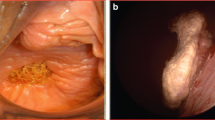Abstract
Does local injection with lidocaine plus epinephrine prior to vaginal reconstructive surgery with synthetic mesh affect exposure rates? A retrospective comparison.
Purpose
To determine if local injection, prior to incision with lidocaine plus epinephrine (L + E) influences the rate of mesh exposure in the early postoperative period following synthetic mesh augmented vaginal reconstructive surgery (MAVR).
Methods
We performed a chart review over an 18-month period of patients who underwent MAVR. The presence of mesh exposure at the 3-month postoperative visit, demographic data and whether or not L + E was used to hydrodissect was recorded. Statistical analysis was performed to determine whether hydrodissection influenced erosion rates.
Results
A total of 143 meshes were placed, hydrodissection with L + E was used in 78 cases and was not in the remaining 65 cases. There were 10 (7.0% 10/143) total erosions at the 3-month postoperative visit, 6 (7.7%; 6/78) in the group that got L + E and 4 (6.2%; 4/65) in the group that did not get local injection. This difference was not significant (p = 0.740, OR 1.54 95% CI 0.41–5.76). There was no difference between the two groups in terms of age, presence of diabetes, concurrent incontinence repair or estimated blood loss.
Conclusion
Mesh exposure is a known complication of MAVR. Our study suggests that local injection with L + E prior to vaginal surgery does not influence exposure rates.
Similar content being viewed by others
References
Le TH, Kon L, Bhatia NN, Ostergard DR (2007) Update on the utilization of grafts in pelvic reconstruction surgeries. Cur Opin Obstet Gynecol 19:480–489
Reisenauer C, Kirschniak A, Drews U, Wallwiener D (2007) Anatomical conditions for pelvic floor reconstruction with polypropylene implant and its application for the treatment of vaginal prolapse. Eur J Obstet Gynecol Reprod Biol 131:214–225
http://www.fda.gov/MedicalDevices/Safety/AlertsandNotices/PublicHealthNotifications/
Finamore P, Echols KT, Hunter K, Goldstein HB, Holzberg AS, Vakili B (2010) Risk factors for mesh erosion three months following vaginal reconstructive surgery using commercial kits vs. fashioned mesh augmented vaginal repairs. Int Urogynecol J Pelvic Floor Dysfunct 21:285–291
Leffler KS, Thompson JR, Cundiff GW, Buller JL, Burrows LJ, Schon Ybarra MA (2001) Attachment of the rectovaginal septum to the pelvic sidewall. Am J Obstet Gynecol 185:41–43
Jakus SM, Shapiro A, Hall CD (2008) Biologic and synthetic graft use in pelvic surgery: a review. Obstet Gynecol Surv 63:253–266
Jia X, Glazener C, Mowatt G et al (2008) Efficacy and safety of using mesh or grafts in surgery for anterior and/or posterior vaginal wall prolapse: systematic review and meta-analysis. BJOG 115:1350–1361
Araco F, Gravante G, Sorge R et al (2009) The influence of BMI, smoking and age on vaginal erosions after synthetic mesh repair of pelvic organ prolapses: a multicenter study. Acta Obstet Gynecol Scand 88:772–780
Ganji FA, Ibeanu OA, Bedenstani A et al (2009) Complications of transvaginal monofilament polypropylene mesh in pelvic organ prolapse repair. Int Urogynecol J Pelvic Floor Dysfunct 20:919–925
Ghezzi F, Cromi A, Raio L et al (2005) Influence of the type of anesthesia and hydrodissection on the complication rate after tension-free vaginal tape procedure. Eur J Obstet Gynecol Reprod Biol 118:96–100
Conflict of interest
The authors declare that they have no conflict of interest.
Author information
Authors and Affiliations
Corresponding author
Rights and permissions
About this article
Cite this article
Finamore, P.S., Hunter, K., Goldstein, H.B. et al. Does local injection with lidocaine plus epinephrine prior to vaginal reconstructive surgery with synthetic mesh affect exposure rates? A retrospective comparison. Arch Gynecol Obstet 284, 659–662 (2011). https://doi.org/10.1007/s00404-010-1715-7
Received:
Accepted:
Published:
Issue Date:
DOI: https://doi.org/10.1007/s00404-010-1715-7




